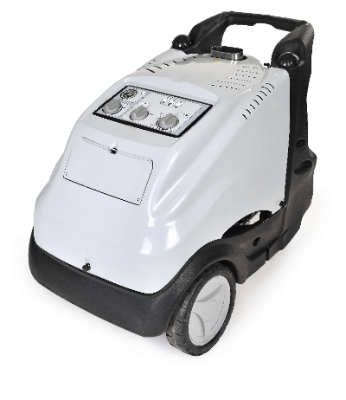What Is a Hot Water High-Pressure Cleaner?

A hot water high-pressure cleaner is a device that uses heated water under high pressure for cleaning purposes.
Such cleaners are particularly effective for removing stubborn oil stains and sterilizing surfaces. They typically operate at discharge pressures around 10 MPa and can heat water to 80°C to enhance cleaning efficiency.
These machines are versatile, used both indoors and outdoors, and include variants that operate without AC power, such as engine-powered models.
Uses of Hot Water High-Pressure Cleaners
Hot water high-pressure cleaners find applications across various settings, including factories, hotels, construction sites, and for both commercial and residential purposes.
Indoors, they are used for cleaning oil stains in kitchens, ventilation systems, and equipment. Outdoors, these cleaners are ideal for vehicle maintenance, cleaning at gas stations, and even washing trains, airplanes, and ships. Portable models extend their utility to cleaning building exteriors, and roofs, and are also utilized in agriculture and livestock management.
Principle of Hot Water High-Pressure Cleaners
1. Effects of Hot Water Washing
Hot water enhances cleaning by reducing water’s viscosity, improving its ability to dissolve oils, and making it easier to penetrate crevices for more effective cleaning. This property is especially useful for removing oil and grease stains, even in cold conditions.
2. Other Effects of Hot Water Cleaning
Beyond grease, hot water is effective against bird droppings, which can cause corrosion, and pollen, which contains coagulating proteins. Hot water can also be used for weeding, with certain models capable of reaching temperatures up to 98°C, suitable for both weeding and sterilizing equipment surfaces.
Types of Hot Water High-Pressure Cleaners
These cleaners are categorized by their heating source: electric, kerosene or light oil, and engine-powered models. Sizes and power sources vary, with larger models typically used in commercial and industrial settings and compact models for residential or light commercial use.
1. Electric Heating Type
Electric models are either instantaneous, using a heat exchanger, or include a hot-water tank for storage. These are generally smaller and suited for less demanding tasks.
2. Kerosene- and Light Oil-Heated Type
These models feature a boiler for heating water and are available in a range of sizes. Their design focuses on efficiency and safety, with insulation to minimize heat loss.
3. Engine Type
Engine-powered cleaners are versatile, operating without a direct power source, and suitable for remote or outdoor use. They can also reach higher temperatures for steam cleaning, with options for gasoline or diesel engines, including biodiesel-compatible models for environmental consideration.